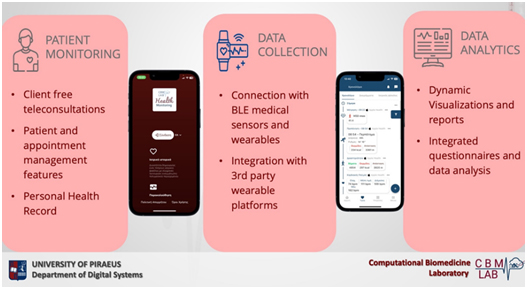ILIAS MAGLOGIANNIS
ABSTRACT
ABSTRACT
Digital Health and Artificial Intelligence
The digital era in health represents an unprecedented shift in how our society approaches health, leveraging technology to revolutionize every aspect of the healthcare services provision. From electronic health records that facilitate patient information management to telemedicine platforms that enable remote consultations, digital health solutions are enhancing accessibility, efficiency, and quality of care. Wearable devices can nowadays monitor vital signs in real-time, empowering individuals to actively participate in their health management and provide insights for holistic health management. Big data analytics discover knowledge from vast amounts of health information, facilitating personalized treatment plans, risk stratification and predictive healthcare interventions. Furthermore, artificial intelligence aids in diagnosing diseases, optimizing treatment protocols, and even discovering novel therapies. Modern e-health systems follow the principles of human centered computing, which are Decentralization, Diversification Connectivity and Simplicity, employing state of the art technologies such as the Internet of Things (ΙοΤ), Context Awareness and Explainable AI.
The Computational Biomedicine Laboratory http://www.cbml.ds.unipi.gr has developed integrated homecare solutions incorporating communication functionalities such as WebRTC, wearable devices and intelligent data processing modules for supporting chronic patients and seniors’ independent living and allow the continuous monitoring of their health status. Furthermore, we have extended their utility beyond conventional monitoring, by introducing affective computing capabilities would allow for early detection of potentially dangerous situations, as an individual’s emotional state has a direct effect on their health, cognitive status, behavior and quality of life.
The lab, being also consistent with the latest advancement in the field of AI, has shown progress in analyzing explainability techniques with reference to medical imaging classification tasks and proposing improvements on well-established explainability algorithms. The provision of visual explanations that demonstrate the most influential areas of the image concerning the classification result is of major importance to decision making systems. The importance grows exponentially when referring to automated systems in the healthcare environment. By developing explainable systems by design or even as post-hoc approaches, trustworthiness and transparency are the added values that can bring domain experts closer to the AI paradigm.
In this talk, we will present the utilization of these technologies in various cases (i.e chronic patients, COVID-19, patients with mental diseases, medical image analysis, etc), focusing on their advanced capabilities and limitations.

Figure: CBML remote health monitoring application